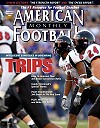AMERICAN FOOTBALL MONTHLY THE #1 RESOURCE FOR FOOTBALL COACHES
Article CategoriesAFM Magazine
|
Simplifying Offensive Play Calling In the Spread Offenseby: Joseph Kanach© More from this issue Looking back throughout my coaching career, I am often amazed at how complicated and wordy the offensive systems I have coached in have been. Even as I read new articles on offensive football strategies, I am dumbfounded at how wordy these plays can become. Therefore, when I earned my first offensive coordinator position, I wanted a simplistic way to get across as much information to my players with as little wording as possible. As I started to design the new offensive system, I wanted every term or number to mean something in our system. Without going into my own personal philosophies on offense, I hope that you can gain some appreciation for how we call our offense and incorporate some of the ideas I will present here. At Springfield High School, we use an offensive system that conveys an immense amount of inform....The full article can only be seen by subscribers. Subscribe today!
|
|
|||||||
| HOME |
MAGAZINE |
SUBSCRIBE | ONLINE COLUMNISTS | COACHING VIDEOS |
Copyright 2025, AmericanFootballMonthly.com
All Rights Reserved





